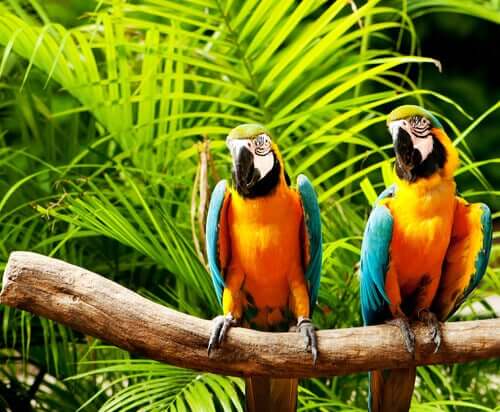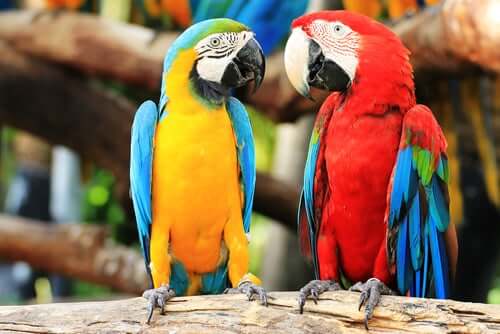Environmental Enrichment for Pet Parrots


Written and verified by the vet Eugenio Fernández Suárez
Psittacidae, commonly known as parrots, are fascinating wild animals. This, together with their enormous intelligence and the richness of their social relationships, makes environmental enrichment for pet parrots something to take into consideration. This is especially the case if we’re sharing our homes with these amazing animals.
Environmental enrichment is a method we can use to improve the welfare of our pets. More often than not, living in captivity doesn’t meet the animal’s needs. Therefore, we should do our best to provide the animals with an environment that resembles their own habitat as much as possible.
In this way, their behavior can be more natural and their well-being much like living in the wild.
Enrichment for pet parrots
Social enrichment is vital
In the case of birds, experts recommend having them in pairs. However, in the case of pet parrots, this is especially important. Parrots are a species of bird that needs to socialize all the time, and ideally have other members of their species or other related ones around. Most parrots can get on well with each other even if they’re not of the same bird family.

If they don’t share a space with another parrot or bird as a partner, they’ll likely be very dependent on us. This can develop issues like separation anxiety and psychological distress, very similar to depression.
Good foraging encouragement
When we talk about foraging, we’re referring to the time the bird spends searching for its food and their eating behaviors. Pet parrot feeding is very technical and varied, and we can do our best to spice it up for them and get their interest.
A very effective method of environmental enrichment for parrots is the use of foraging trays. This consists of placing different substrates and objects mixed with food in a tray. As a result, we can combine substrates, objects, and food to make hundreds of different kinds of trays:
- Foodstuffs: peanuts, dried fruit, apple or carrot pieces, cooked pasta, etc.
- Substrate: shavings, torn newspaper, confetti, hay, etc.
- Objects: tweezers, stoppers, corks, ropes, etc.
There are also many environmental enrichment devices for pet parrots that allow us to make their food a little more complicated. Some of these are bamboo tubes, coconuts, or even toys that need to be levered so that our pet gets its food.
Another idea could be to place the fruit in a special way, such as making apple and carrot garlands or putting the fruit in baskets where it has to manipulate its food in order to eat it.
Using foraging trays is an effective method for enriching their environment. This consists of placing different substrates and objects mixed with food on a tray. We can combine all these elements to produce many kinds of different foraging trays.
Music, a perfect sensory enrichment
An ideal method for enriching our pet parrot’s environment is the use of music. Many parrots have a sense of rhythm and a genuine passion for imitating and reproducing the sounds they hear. This characteristic makes parrots, and especially cockatoos, unique in the animal kingdom. In addition, they are even capable of dancing to music.
However, before we do this, we must take some precautions. Some rhythms or sounds can be annoying for our pets. The ideal scenario is to start with relaxing sounds, such as classical music, and try different genres little by little. Getting to know our pet is vital for practicing any kind of enrichment, as some may not be to the liking of certain individuals.

Dancing parrots have revealed that humans aren’t the only animals that can groove to different beats.
Free flight
Parrots are birds and they need to fly, naturally. Therefore, one of the best enrichment techniques we can give them is to allow them to fly freely in wide spaces. Ideally, you should have an aviary or let them fly freely around your house.
Keep in mind that, given the complexity of these birds, positive reinforcement training is very important to help us live with them.
Such training can be done by a professional, such as an ethologist or a veterinarian. If we feel up to it, we can even train our birds to fly freely, that is, outdoors, without fear of them escaping or suffering any mishaps.
We hope you enjoyed today’s article on these beautiful animal friends, happy birding!
Psittacidae, commonly known as parrots, are fascinating wild animals. This, together with their enormous intelligence and the richness of their social relationships, makes environmental enrichment for pet parrots something to take into consideration. This is especially the case if we’re sharing our homes with these amazing animals.
Environmental enrichment is a method we can use to improve the welfare of our pets. More often than not, living in captivity doesn’t meet the animal’s needs. Therefore, we should do our best to provide the animals with an environment that resembles their own habitat as much as possible.
In this way, their behavior can be more natural and their well-being much like living in the wild.
Enrichment for pet parrots
Social enrichment is vital
In the case of birds, experts recommend having them in pairs. However, in the case of pet parrots, this is especially important. Parrots are a species of bird that needs to socialize all the time, and ideally have other members of their species or other related ones around. Most parrots can get on well with each other even if they’re not of the same bird family.

If they don’t share a space with another parrot or bird as a partner, they’ll likely be very dependent on us. This can develop issues like separation anxiety and psychological distress, very similar to depression.
Good foraging encouragement
When we talk about foraging, we’re referring to the time the bird spends searching for its food and their eating behaviors. Pet parrot feeding is very technical and varied, and we can do our best to spice it up for them and get their interest.
A very effective method of environmental enrichment for parrots is the use of foraging trays. This consists of placing different substrates and objects mixed with food in a tray. As a result, we can combine substrates, objects, and food to make hundreds of different kinds of trays:
- Foodstuffs: peanuts, dried fruit, apple or carrot pieces, cooked pasta, etc.
- Substrate: shavings, torn newspaper, confetti, hay, etc.
- Objects: tweezers, stoppers, corks, ropes, etc.
There are also many environmental enrichment devices for pet parrots that allow us to make their food a little more complicated. Some of these are bamboo tubes, coconuts, or even toys that need to be levered so that our pet gets its food.
Another idea could be to place the fruit in a special way, such as making apple and carrot garlands or putting the fruit in baskets where it has to manipulate its food in order to eat it.
Using foraging trays is an effective method for enriching their environment. This consists of placing different substrates and objects mixed with food on a tray. We can combine all these elements to produce many kinds of different foraging trays.
Music, a perfect sensory enrichment
An ideal method for enriching our pet parrot’s environment is the use of music. Many parrots have a sense of rhythm and a genuine passion for imitating and reproducing the sounds they hear. This characteristic makes parrots, and especially cockatoos, unique in the animal kingdom. In addition, they are even capable of dancing to music.
However, before we do this, we must take some precautions. Some rhythms or sounds can be annoying for our pets. The ideal scenario is to start with relaxing sounds, such as classical music, and try different genres little by little. Getting to know our pet is vital for practicing any kind of enrichment, as some may not be to the liking of certain individuals.

Dancing parrots have revealed that humans aren’t the only animals that can groove to different beats.
Free flight
Parrots are birds and they need to fly, naturally. Therefore, one of the best enrichment techniques we can give them is to allow them to fly freely in wide spaces. Ideally, you should have an aviary or let them fly freely around your house.
Keep in mind that, given the complexity of these birds, positive reinforcement training is very important to help us live with them.
Such training can be done by a professional, such as an ethologist or a veterinarian. If we feel up to it, we can even train our birds to fly freely, that is, outdoors, without fear of them escaping or suffering any mishaps.
We hope you enjoyed today’s article on these beautiful animal friends, happy birding!
This text is provided for informational purposes only and does not replace consultation with a professional. If in doubt, consult your specialist.








